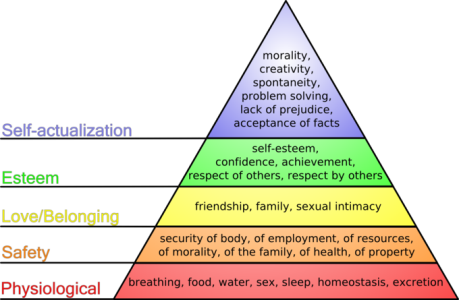"Critically compare and contrast Maslow and Rogers accounts of the Self-Actualised/Fully Functioning Person with Positive Psychological Theories of the 'Wise Person'."
Talk about the similarities and differences
Self actualisation defined by Larsen and buss as a "growth based motive, a motive to develop, to flourish and become to become more and more what one is destined to become". The humanistic domain of psychology focuses on the individual's potential and stresses the importance of growth and self-actualization. This essay will be compare and contrast two personality theories of self actualization from Abraham Maslow s hierarchy of needs and Carl Rogers concept of the fully functioning person.
Get Help With Your Essay
If you need assistance with writing your essay, our professional essay writing service is here to help!
Self- actualization to maslow represents growth of an individual toward fulfilment of the highest need. Maslow (1968) defined it as 'the process of becoming more and more what one idiosyncratically is, to become everything that one is capable of becoming'. Maslow suggested that individual are not doing what they were made to do, they simply cannot feel completely fulfilled, therefore making the individual feel unsettled about their future. Both Maslow and Rogers agrees that everyone is good and are able to self actualize.
Maslow was the first to research and initiate the area of the motive to self actualization. His theory stems around the concept of 'need' , maslow hierarchy reflects a linear pattern of growth and are hierarchically organised. More basic needs are found at the bottom of the pyramid and the self actualization need is at the top. The bottom of the pyramid is the most important of the hierarchy in terms of survival of an individual compared to the higher level needs (figure 1) in order to get to the top the bottom must all be satisfied. Maslow's hierarchy is described as follows:
- At the bottom of the pyramid are the psychological (or basic) needs of a human being: breathing, food, water, sleep, sex. The next level is safety needs: security, order and stability. These two levels are highly important for the basic survival of the individual. Once this is all accomplished they can attempt more.
- The third level of need is love and belonging : once the individual has taken care of themselves they are ready to share themselves to others such as having as having family and friends. The fourth level is esteem- this is achieved when individuals feel comfortable with what they have accomplished, Maslow (1968) believed individuals needed satisfy two types; esteem from others and self esteem; individuals wants to be recognised by others as successful as well as recognition of their achievements and abilities. When individuals gain this esteem from others it is translated into self esteem; sees themselves as being good and valuable.
- The top of the hierarchy is the self- actualization need. This is where the individual know who they are or what they want to be and have very little doubts when making decisions about their direction of life. It's a state of harmony and understanding because their full potential has been achieved. Maslow identified these kind of individuals who have peak experiences and are highly creative.
Maslow (1968) claimed that lower levels of needs within the hierarchy pyramid needs to be satisfied first before satisfying the higher ones. This is because the lower level needs are more powerful and urgent to achieve due to its relevancy of survival. The needs are arranged specially in order to show that an individual has to his have enough food and feel safe before attempting to earn esteem. Maslow (1968) suggested that the hierarchy was designed to reflect the average individual, it emerges during human development -satisfying the lower needs early in life and gradually as the individual develops these needs, then the higher needs will fall into place and becomes satisfied. Maslow (1968) also theorized that individuals who attempted to go straight to higher needs their motivation will be weak and easily disrupted. 'This inner tendency toward self actualization is not strong and overpowering and unmistakable like the instincts of animals. It is weak and delicate and subtle and easily overcome by habit, cultural pressures and wrong attitudes toward it,' (Maslow ,1968).
Even though Maslow's hierarchy is popular however he had little evidence to prove this theory, this theory it was based on his own personal thoughts about motivation towards self actualization. Rogers(1902-1987)had an alternative explanation to self actualization he called it the fully functioning person-"The organism has one basic tendency and striving - to actualize, maintain, and enhance the experiencing organism" (Rogers, 1951). He believed that a fully functioning person is an individual who is already or on theory way to becoming self actualized- this occurs when a person ideal self(who they would like to be) is congruent with their actual behaviour (self-image). He believed that everyone could achieve their goals, wishes and desires in life and when the person has done so, self - actualization takes place. Rogers (1961) says that not everyone can self-actualize and the people that do reach to that are called fully functioning person.- the person is in touch with her and now and the individuals experiences and feelings are continually growing and changing "Such a person experiences in the present, with immediacy. He is able to live in his feelings and reactions of the moment. He is not bound by the structure of his past learning's, but these are a present resource for him in so far as they relate to the experience of the moment. He lives freely, subjectively, in an existential confrontation of this moment in life," Rogers (1962) article).

Figure 2
In figure 2 Rogers identified five charteristics of the fully functioning person:
- Open to experience-both negative and positive feelings are accepted. Negative feelings are not cast away alternatively worked through them.
- Existential living- avoids prejudging and preconceptions in situations. Being able to enjoy the current moment and not always looking back in the past or forward to the future (living for the moment).
- Trust feelings-trusting their own feelings and judgement and not seeking for anyone else for guidance. Trusting that their own decisions are the right one.
- Creativity-the ability to adjust, change and seek new experiences. Risk taking and not playing safe all the time. Have creative thinking in the person's life.
- Fulfilled life- the person is happy and satisfied with life yet still looking for new challenges and experiences.
Rogers (1959) suggests that people want to feel and experience and behave in ways which are consistent with their self-image which reflect what we would like to be like, ideal-self. The closer the self-image and ideal self are to each other.
The self concept includes three components:
Self worth/or self esteem- what the person think about ourselves. Rogers believed this developed in early childhood formed from interaction of the child and parents
Self image-how the person sees themselves
Ideal self-this is how the person would like to be .consisting of goals and ambitions in life.
Rogers believed people need to be regarded by others positively , loved and respected. Positive regards is to do with how people see them in social interactions. There are two types unconditional positive regard and conditional positive regards. Rogers believed that all infants had a need to be psotively self-regarded
Unconditional positive regard-this is where the parents accepts and loves the child for who they are. People who can self-actulize are more likely to have received unconditional positive regards from others, especially parents.
Condtional positive- the child behaves in a way where the parents approve of. The child is not loved for who they really is only in ways where their behaviour is based upon what they feel the parents consider correct. A person who constantly seeks for approval from others is likely to have experienced conditional positive regards as a child.
This is where Rogers and Maslow theories contrasted, Rogers believed that early childhood experiences are important for the person to achieve self actualization however Maslow did not take this into consideration and only focused primarily on achieving needs within the hierarchy.
The two theories have a similar paths in terms of individuals following their on way to achieve self actualization and more basic needs in terms of survival needs have to be satisfied first before an individual can achieve self actualization. They both agree on being accepted can be more influential than the need for self-actulization.
They both contrast in what they focus on after defining self actualization. Maslow focused on understanding the characteristics of a self actlizaing individuals. Rogers looked at the characteristics but also considered the ways achieve self actualization as well as developing therapy to overcome barriers that where restricting individuals from achieving their full potential. Maslow supported his theory by studying some people who he thought has reached their full potential such as Albert Einstein and Thomas Jefferson. He found that self actualized people apperared to share similar charactestic traits.
Find Out How UKEssays.com Can Help You!
Our academic experts are ready and waiting to assist with any writing project you may have. From simple essay plans, through to full dissertations, you can guarantee we have a service perfectly matched to your needs.
View our academic writing services
Maslow estimated only one percent of individuals are motivated in becoming self actualised (Larsen and Buss ,2008) however rogers believed that everyone is capable of becoming self actualized. The only thing that are stopping them is being fixated on conditions of worth where in his therapy removes that from his clients so they can continue on the route to becoming self actualised.
Overall, between the two theories of self actualization it appears to show that rogers believes that all people can aim to become self actualized on the other hand Maslow only thinks that a small percentage can strive to that level. Rogers primarly focused on therapy to help individuals to help reach to the full pontential and Maslow agreed with this technique. Suggesting that the two theories are similar in terms of their description and definition of self actualization- similar chaterstics and traits. No research findings have suggested what theory is more valid than the other as they are both have a similar in terms of their theoretical basis towards self actualization. Although it suggestsd that Rogers ideas are more valid as his reaserch includes therapy of clients, as Maslows had little evidence ot was base on his own personal thoughts.
References
Rogers, C. (1951). Client-centered therapy: Its current practice, implications and theory. London: Constable.
Rogers, C. (1959). A theory of therapy, personality and interpersonal relationships as developed in the client-centered framework. In (ed.) S. Koch, Psychology: A study of a science. Vol. 3: Formulations of the person and the social context. New York: McGraw Hill.
Rogers, C. R. (1961). On Becoming a person: A psychotherapists view of psychotherapy. Houghton Mifflin.
Rogers, C. R., Stevens, B., Gendlin, E. T., Shlien, J. M., & Van Dusen, W. (1967). Person to person: The problem of being human: A new trend in psychology. Lafayette, CA: Real People Press.
Cite This Work
To export a reference to this article please select a referencing style below:



